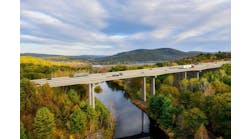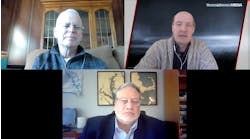A new, permanent, ultra-fast-setting concrete repair material now available in the U.S. helped a contractor speed through multiple concrete slab repairs at Colorado Springs Airport late in 2001.
The repairs, done at night and under stiff penalties for failure to vacate the work area by 5 a.m. for air traffic, addressed serious spalling of concrete on runways and taxiways.
The airport’s elevation is 6,183 ft (1.2 miles) above sea level. Because of the thinner atmosphere at this height, aircraft must take longer runs for takeoff, especially in summer when the air is warmer and less dense.
As a result, the airport has the longest runway in Colorado, 13,500 ft (2.5 miles). In fact, Boeing Co. regularly uses Colorado Springs Airport to conduct high-altitude landing and takeoff performance testing of its commercial aircraft, including the newest 757 and 777 models. There are three runways at the airport, dual parallel and one crosswind runway, which occupies 7,135 acres southeast of the city.
In 2000, the last year for which firm figures are available, some 2.4 million passengers arrived on approximately 100 daily arrivals and departures, part of a total of 220,739 aircraft operations. Owned and operated by the city of Colorado Springs, the facility opened in October 1994 and features multiple sites available for commercial lease and development, some including runway access.
Done by dawn
With all this activity, it’s little wonder the city wanted concrete repairs executed at night, when the slower pace allowed one runway to handle traffic while others were shut down for repairs.
The contractor, T.L. Smith Inc., Tucson, Ariz., agreed to undertake the work at night during certain hours when aircraft operations were slowed.
“Work areas had to be opened up to aircraft in the morning,” said Thomas L. Smith, vice president, T.L. Smith. “So the time period of cutting spalls, chipping them out and filling them in was critical.”
T.L. Smith specializes in concrete sawing and sealing, spall repair, drilling and epoxy injection for runways, highways and bridges. At Colorado Springs, Smith’s crews worked weeknights, under flood lights, for just under three weeks for this project, repairing over 200 sq yd of airfield. Work began at 7 p.m. when air traffic was shifted to one runway, and the crews would work through to 5 a.m. the next morning.
The new material, a fast-setting, proprietary product called TechCrete (Circle 922), enabled the contractor to speed up the process and do more repairs in one shift in the limited hours before dawn. TechCrete is marketed by Crafco Inc., Chandler, Ariz. The material effects a full permanent repair in less than an hour, but typically sets up much faster than that.
A small patch of time
“It’s a very simple product, and that is one of its greatest attributes, we found,” said Bret Andreasen, project manager and secretary/treasurer of T.L. Smith. “Everything is premeasured. You put it in a machine, the ‘pot,’ which heats and stirs it up; and you dump it in the ground and walk away.
“The other great attribute is that it sets rapidly. You can get traffic on it literally 15 minutes after placement. We witnessed this; it worked for us.”
The simplicity of application at night, and the speed of set time under these time-critical constraints, meant money to T.L. Smith.
“It was invaluable,” Andreasen said. “It allowed us to work throughout the whole shift. Products with two-hour curing windows would require a whole crew to work six hours, and then be sent home, but be paid for eight. With a 10- or 12-man crew you can be throwing hundreds of dollars away per shift in labor costs. But while you’re waiting for this material to cure, you can be sure that it will set up before you have to get off the runway.”
“We were allowed six hours each night in which to work, including set time, so it was important that the patch would set up fast and be able to take the traffic right away,” Smith said.
Quick pay
For this spall repair work, Smith’s crews would do a squared edge saw cut to 1 in. depth about 3 in. around the spall. Using 60-lb air hammers, the crews would chip out the damaged concrete down to sound material. The patch would be cleaned out and air blasted to remove moisture and fines.
At the same time, the premeasured units of TechCrete would have been melting in the pot, Andreasen said. Then, a supplied primer would be placed on the patch area, and after a five- to 10-minute wait, the material would be spread in the patch with buckets or, for larger patches, placed in the patch directly from the pot.
No vibration or floats are required, but Andreasen’s crews used a hot iron to minimally flatten or move the patch material for final finish. Finally, a specified, high-performance aggregate would be placed over the patching material before the material had cooled down to a firm consistency.
There was little margin for error under the time constraints of the night-work project, but the proprietary product eliminated much of the guesswork and opportunity for problems, Andreasen said. “It’s error-proof and easy to use for your employees,” he said. “Error-proof products are valuable to a contractor.”
“You can put traffic on it so soon. Even if a plane had to land in an emergency, we could have sprayed water on the material and it would have set up within 10 minutes,” said Smith.
The airport authority was so pleased with the outcome of the work that it released T.L. Smith’s 10% retention fee from progress payments only 60 days after completion. “They can hold it for a year to ensure performance, but released it after only two months,” Smith said. “They were very good people to work for.”
While the product is ideal for time-sensitive jobs like airfield repairs, T.L. Smith acknowledges that it’s applicable for time-critical night work on expressways or interstate highways as well.
“For major freeways in our state, all of the work has to be done at night,” Smith said. “You have to have a material which sets up quickly because your time frame only will be six to eight hours.” The firm is familiarizing the Arizona Department of Transportation with the product’s performance and hopes to have a demonstration application there later in 2002.
Information for this article submitted by Crafco Inc., Chandler, Ariz.


